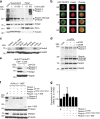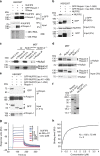Binding of NUFIP2 to Roquin promotes recognition and regulation of ICOS mRNA
- PMID: 29352114
- PMCID: PMC5775257
- DOI: 10.1038/s41467-017-02582-1
Binding of NUFIP2 to Roquin promotes recognition and regulation of ICOS mRNA
Abstract
The ubiquitously expressed RNA-binding proteins Roquin-1 and Roquin-2 are essential for appropriate immune cell function and postnatal survival of mice. Roquin proteins repress target mRNAs by recognizing secondary structures in their 3'-UTRs and by inducing mRNA decay. However, it is unknown if other cellular proteins contribute to target control. To identify cofactors of Roquin, we used RNA interference to screen ~1500 genes involved in RNA-binding or mRNA degradation, and identified NUFIP2 as a cofactor of Roquin-induced mRNA decay. NUFIP2 binds directly and with high affinity to Roquin, which stabilizes NUFIP2 in cells. Post-transcriptional repression of human ICOS by endogenous Roquin proteins requires two neighboring non-canonical stem-loops in the ICOS 3'-UTR. This unconventional cis-element as well as another tandem loop known to confer Roquin-mediated regulation of the Ox40 3'-UTR, are bound cooperatively by Roquin and NUFIP2. NUFIP2 therefore emerges as a cofactor that contributes to mRNA target recognition by Roquin.
Conflict of interest statement
The authors declare no competing financial interests.
Figures








Similar articles
-
Roquin paralogs 1 and 2 redundantly repress the Icos and Ox40 costimulator mRNAs and control follicular helper T cell differentiation.Immunity. 2013 Apr 18;38(4):655-68. doi: 10.1016/j.immuni.2012.12.004. Epub 2013 Apr 11. Immunity. 2013. PMID: 23583643
-
Roquin binds inducible costimulator mRNA and effectors of mRNA decay to induce microRNA-independent post-transcriptional repression.Nat Immunol. 2010 Aug;11(8):725-33. doi: 10.1038/ni.1902. Epub 2010 Jul 18. Nat Immunol. 2010. PMID: 20639877
-
Evolution of the RNA alternative decay cis element into a high-affinity target for the immunomodulatory protein Roquin.RNA Biol. 2025 Dec;22(1):1-12. doi: 10.1080/15476286.2024.2448391. Epub 2025 Jan 13. RNA Biol. 2025. PMID: 39801464 Free PMC article.
-
Roquin--a multifunctional regulator of immune homeostasis.Genes Immun. 2016 Mar;17(2):79-84. doi: 10.1038/gene.2015.58. Epub 2015 Dec 17. Genes Immun. 2016. PMID: 26673963 Free PMC article. Review.
-
Molecular control of Tfh-cell differentiation by Roquin family proteins.Immunol Rev. 2013 May;253(1):273-89. doi: 10.1111/imr.12056. Immunol Rev. 2013. PMID: 23550652 Review.
Cited by
-
Differential expression of plasma extracellular vesicles microRNAs and exploration of their association with bone metabolism in childhood trauma participants treated in a psychosomatic clinic.Front Endocrinol (Lausanne). 2025 Feb 26;16:1515910. doi: 10.3389/fendo.2025.1515910. eCollection 2025. Front Endocrinol (Lausanne). 2025. PMID: 40078585 Free PMC article.
-
The Immunomodulatory Properties of the Human Amnion-Derived Mesenchymal Stromal/Stem Cells Are Induced by INF-γ Produced by Activated Lymphomonocytes and Are Mediated by Cell-To-Cell Contact and Soluble Factors.Front Immunol. 2020 Feb 12;11:54. doi: 10.3389/fimmu.2020.00054. eCollection 2020. Front Immunol. 2020. PMID: 32117234 Free PMC article.
-
Roquin exhibits opposing effects on RNA stem-loop stability through its two ROQ domain binding sites.Proc Natl Acad Sci U S A. 2025 Apr 15;122(15):e2424434122. doi: 10.1073/pnas.2424434122. Epub 2025 Apr 9. Proc Natl Acad Sci U S A. 2025. PMID: 40203046 Free PMC article.
-
Interactome Networks of FOSL1 and FOSL2 in Human Th17 Cells.ACS Omega. 2021 Sep 16;6(38):24834-24847. doi: 10.1021/acsomega.1c03681. eCollection 2021 Sep 28. ACS Omega. 2021. PMID: 34604665 Free PMC article.
-
Defining the ATPome reveals cross-optimization of metabolic pathways.Nat Commun. 2020 Aug 28;11(1):4319. doi: 10.1038/s41467-020-18084-6. Nat Commun. 2020. PMID: 32859923 Free PMC article.
References
Publication types
MeSH terms
Substances
Grants and funding
LinkOut - more resources
Full Text Sources
Other Literature Sources
Molecular Biology Databases
Research Materials
Miscellaneous

